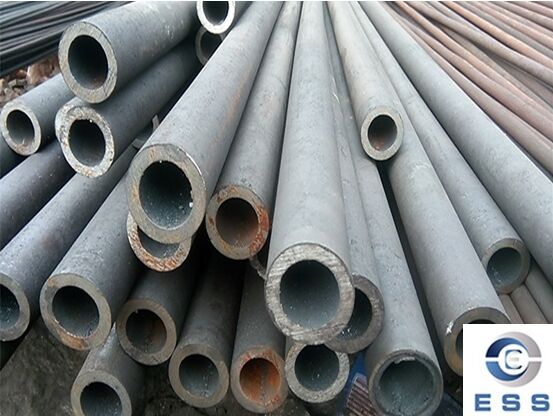
The main components of mild
steel pipe are carbon, silicon, manganese, phosphorus, sulfur, etc. These
elements have an important influence on the performance of mild steel pipe and
are widely used in various fields.
Mild steel pipe is a kind of steel with low
carbon content. It is widely used in various fields due to its excellent
performance. Understanding the chemical composition of mild steel pipe is
crucial to understanding its performance characteristics. Next, let's analyze
the main chemical composition of mild steel pipe in detail.
Main chemical composition of mild steel
pipe
1. Carbon (C)
Carbon is the main alloying element of carbon
steel pipe, and its content is usually below 0.25%. The carbon content
determines the strength, hardness and wear resistance of steel. As the carbon
content increases, the strength and hardness of mild steel pipe will also
increase accordingly, but the plasticity and toughness will decrease.
2. Silicon (Si)
Silicon mainly exists in the form of
silicide in mild steel pipe, which helps to improve the strength and corrosion
resistance of steel. The right amount of silicon can also improve the welding
performance of mild steel pipe. In the construction field, mild steel pipes
used to manufacture steel structures and bridges can enhance their corrosion
resistance and welding performance through the action of silicon, ensuring the
stability and safety of the structure.
3. Manganese (Mn)
Manganese is an important alloying element
in mild steel pipes, which can improve the strength and toughness of steel. At
the same time, manganese can also reduce the brittle transition temperature of
steel and improve low-temperature toughness. When manufacturing pipelines such
as boiler
tube that need to withstand large pressures and temperature changes, the
role of manganese is particularly important. It can keep the pipelines in
low-temperature environments. Good toughness can reduce the risk of rupture.
4. Phosphorus (P)
Phosphorus mainly exists in the form of
solid solution in mild steel pipes, which helps to improve the strength and
hardness of steel. However, excessive phosphorus content will reduce the
plasticity and toughness of steel, so the phosphorus content needs to be
controlled. For example, when producing oil casing pipe,
it is particularly important to control the phosphorus content. Excessive
phosphorus content can easily lead to brittle fracture.
5. Sulfur (S)
Sulfur is a harmful element in mild steel
pipes, which will reduce the plasticity and toughness of steel and increase the
hot brittleness of steel. Therefore, the sulfur content needs to be strictly
controlled during the production process.
Table of content ranges of main chemical components
|
Table of content ranges of main chemical components
|
|
Element
|
Model
|
Content range
|
|
C (carbon)
|
Q235、A106
|
0.05–0.25%
|
|
Si (silicon)
|
——
|
0.10–0.35%
|
|
Mn (manganese)
|
——
|
0.30–1.60%
|
|
P (phosphorus)
|
——
|
≤ 0.045%
|
|
S (sulfur)
|
——
|
≤ 0.050%
|
|
Cu (copper)
|
——
|
0.20–0.55%
|
|
Cr (chromium)
|
——
|
≤ 0.30%
|
|
Ni (nickel)
|
——
|
≤ 0.30%
|
Effect of chemical composition on the
performance of mild steel pipes
1. Elements such as carbon, silicon, and
manganese can improve the strength and hardness of steel, but excessive carbon
content will reduce the plasticity and toughness of steel.
2. Although phosphorus can improve the
strength and hardness of steel, excessive phosphorus content will also reduce
the plasticity and toughness of steel.
3. Sulfur is a harmful element and its
content needs to be strictly controlled to avoid adverse effects on steel
performance.
Typical applications and key points of
material selection
|
Application
fields
|
Typical
grades
|
Key
performance
|
Requirements
|
|
Construction
and bridges
|
Q235
|
Welding
performance, corrosion resistance
|
Emphasis on low hydrogen embrittlement
and easy welding
|
|
Automobile
chassis
|
A53
|
Strength,
impact toughness
|
Requires lightweight, high strength and
fatigue resistance
|
|
Oil
and gas pipelines
|
X42–X65
|
Compression
resistance, low temperature resistance
|
Control carbon equivalent to ensure no
brittle fracture at –40 ℃
|
|
Boiler
and heat exchanger
|
16Mn
|
High
temperature resistance, creep resistance
|
Add
elements such as manganese and chromium to improve stability at high
temperatures
|
|
Mechanical
manufacturing
|
20#
|
Machinability,
wear resistance
|
Ensure good turning and boring processing
performance, and have certain wear resistance
|
Summary
In short, ms pipe is an important metal
material, and its chemical composition has an important influence on its
performance. Understanding the chemical composition of mild steel pipe can help
us better apply this material and give full play to its excellent performance.
At the same time, with the continuous advancement of science and technology and
the continuous development of industry, the application prospects of mild steel
pipe will be broader.
Read more: Difference between mild steel pipe and carbon steel pipe or Sch40 Mild Steel Pipe













 Eastern Steel Manufacturing Co.,Ltd not only improve product production and sales services, but also provide additional value-added services. As long as you need, we can complete your specific needs together.
Eastern Steel Manufacturing Co.,Ltd not only improve product production and sales services, but also provide additional value-added services. As long as you need, we can complete your specific needs together.










